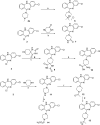The first structure-activity relationship studies for designer receptors exclusively activated by designer drugs
- PMID: 25587888
- PMCID: PMC4368042
- DOI: 10.1021/cn500325v
The first structure-activity relationship studies for designer receptors exclusively activated by designer drugs
Abstract
Over the past decade, two independent technologies have emerged and been widely adopted by the neuroscience community for remotely controlling neuronal activity: optogenetics which utilize engineered channelrhodopsin and other opsins, and chemogenetics which utilize engineered G protein-coupled receptors (Designer Receptors Exclusively Activated by Designer Drugs (DREADDs)) and other orthologous ligand-receptor pairs. Using directed molecular evolution, two types of DREADDs derived from human muscarinic acetylcholine receptors have been developed: hM3Dq which activates neuronal firing, and hM4Di which inhibits neuronal firing. Importantly, these DREADDs were not activated by the native ligand acetylcholine (ACh), but selectively activated by clozapine N-oxide (CNO), a pharmacologically inert ligand. CNO has been used extensively in rodent models to activate DREADDs, and although CNO is not subject to significant metabolic transformation in mice, a small fraction of CNO is apparently metabolized to clozapine in humans and guinea pigs, lessening the translational potential of DREADDs. To effectively translate the DREADD technology, the next generation of DREADD agonists are needed and a thorough understanding of structure-activity relationships (SARs) of DREADDs is required for developing such ligands. We therefore conducted the first SAR studies of hM3Dq. We explored multiple regions of the scaffold represented by CNO, identified interesting SAR trends, and discovered several compounds that are very potent hM3Dq agonists but do not activate the native human M3 receptor (hM3). We also discovered that the approved drug perlapine is a novel hM3Dq agonist with >10 000-fold selectivity for hM3Dq over hM3.
Keywords: CNO; DREADD; SAR; hM3Dq; neuronal activation; perlapine.
Figures






References
-
- Sternson S. M.; Roth B. L. (2014) Chemogenetic Tools to Interrogate Brain Functions. Annu. Rev. Neurosci. 37, 387–407. - PubMed
-
- Urban D. J.; Roth B. L. (2015) DREADDs (Designer Receptors Exclusively Activated by Designer Drugs): Chemogenetic Tools with Therapeutic Utility. Annu. Rev. Pharmacol. Toxicol. 55, 399–417. - PubMed
-
- Penfield W., and Jasper H. H. (1954) Epilepsy and the Functional Anatomy of the Human Brain (First ed.), Little Brown, Boston.
-
- Boyden E. S.; Zhang F.; Bamberg E.; Nagel G.; Deisseroth K. (2005) Millisecond-timescale, genetically targeted optical control of neural activity. Nat. Neurosci. 8, 1263–1268. - PubMed
-
- Armbruster B. N.; Roth B. L. (2005) Mining the receptorome. J. Biol. Chem. 280, 5129–5132. - PubMed
Publication types
MeSH terms
Substances
Grants and funding
LinkOut - more resources
Full Text Sources
Other Literature Sources
Miscellaneous

